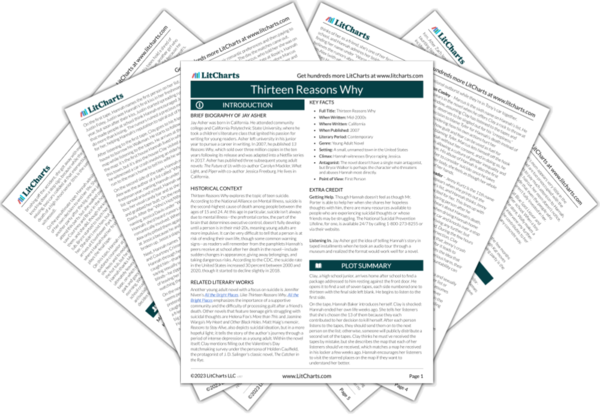Rumors and Reputation
From Hannah’s first weeks at high school, she realizes she can’t control other people’s impressions of her. When her classmate Justin spreads a rumor that Hannah’s first kiss, which he and she shared, went beyond just kissing, he’s the first to chip away at the positive image Hannah’s classmates have of her. Justin’s rumor causes Hannah’s cherished memory of her first kiss—something that made her feel happy and hopeful—to become a source of anxiety…
read analysis of Rumors and ReputationGender, Sexualization, and Agency
Thirteen Reasons Why suggests that when men take advantage of women, feeling that they’re entitled to view, touch, and judge women’s bodies without their permission, they help to maintain an environment of gender inequality that disempowers and distresses women. When Justin spreads the rumor that Hannah let him touch her sexually (when the truth is that they only kissed), not only does everyone believe Justin instead of Hannah, but it’s Hannah, not Justin, who faces…
read analysis of Gender, Sexualization, and AgencyGuilt and Blame
Thirteen Reasons Why focuses on a few tricky questions about guilt and blame: how do our actions affect other people, and should we hold ourselves responsible for their decisions? Though Hannah deliberately chooses the 13 people who she considers most closely tied to her decision to end her life, sending them a package of tapes on which she tells each of them how they hurt and neglected her, she acknowledges throughout the tapes that these…
read analysis of Guilt and Blame
Parental Care and Attention
Through its contrasting depictions of parental behavior, Thirteen Reasons Why shows that the support of reliable and attentive parental figures and mentors is vital to teens’ mental health. Hannah feels neglected and dismissed by her parents and other caregiver figures in her life. Her parents are absent from most of the novel, rarely speaking to her or checking in on her, and they don’t even notice when she has a dramatic haircut. They’re stressed about…
read analysis of Parental Care and Attention






